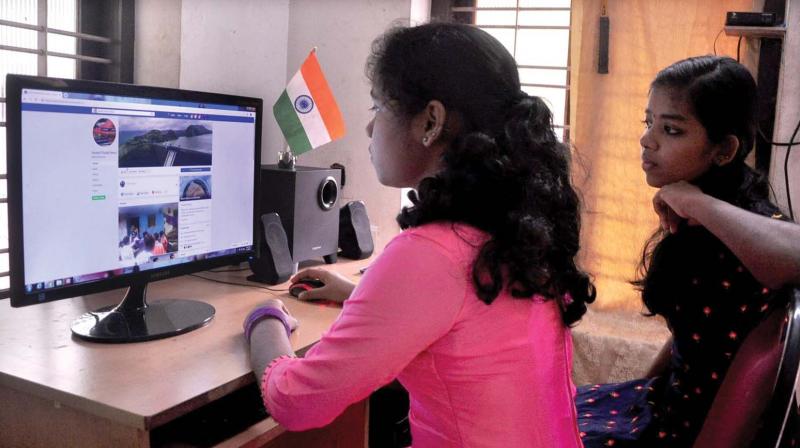Vision to fight myopia
Hereditary factors apart, new habits and lifestyle play an important role in more schoolchildren contracting myopia, a sight disorder.

Kochi: Doctors say children’s habit of being glued to mobiles, computers and television sets is a contributing factor in the increased incidence of myopia and it’s high time a balance is struck in the use of new-age devices.
Indian Medical Association (IMA) and Kerala Society of Ophthalmic Surgeons (KSOS) are now joining hands to combat this abberation by creating awareness in schools on myopia with a programme named ‘Baladarshan.’
“Myopia (short sight or near-sightedness) is one of the common refractive errors of eyes,” said Dr S. Sasikumar, president, Kerala Society of Ophthalmic Surgeons. “It is a condition when objects at a distance will be blurred while near objects will be clear. This can be corrected by appropriate concave lenses. This usually commences around 5-15 years of age and stabilises by 18-20 years.”
“With the changing routine of schoolchildren, more of them get this sight disorder. Although hereditary factors are attributed to this, new habits and lifestyle factors also play an important role,” said Dr Sasikumar.
According to the WHO NPCB (National Programme for Control of Blindness) Survey in 1989, 1.49 percent population in India was blind of which 7.35 percent was due to refractive errors. This has increased to 19.7 percent in the NPCB National Blindness Survey 2005. A review of several studies conducted between 1990 and 2017 which was published in 2018 reveals that this is 10.8 percent among school students, of which majority is due to myopia.
Dr Elizabeth Joseph, HoD, Ophthalmology, LF Hospital, Angamali, said that in a study of 3,03,481 schoolchildren conducted among 500 schools in Thrissur district between 2016 and 2019, a total of 16,403 children were found to have refractive errors, of which 9407 were new. “The data of the study is under compilation,” she said.
Studies have shown that indulgence in near work and lack of outdoor activities is strong predisposing factors for this, said Dr Saju Joseph, ophthalmologist with TVJ Hospital, Kothamangalam, and convenor, Blindness Control Cell of IMA, Kerala. “A study of 12-year-old Australian children suggests that continuous reading and reading at close distance are associated with myopia. By 2050 half the world population is predicted to become myopic with about one billion in the high myopia category,” he said.
“Myopia can be corrected by glasses or contact lenses. There can be natural progression of myopia till 18-20 years of age, after which laser correction can be done (LASIK). In certain cases, progress even beyond the usual period can result in progressive or pathological myopia. Low dose atropine drops have been tried in children to arrest the progression of myopia,” said Dr Saju Joseph.
“In Singapore, the Health Promotion Board (HPB) of the government launched a National Myopia Prevention Programme in 2001. They even made curriculum changes to implement measures to control the factors that can influence myopia. These include changes such as increasing the amount of time for outdoor play and reducing the hours spent on near-work activities. Teachers encourage students to play outdoors during interval time and limit computer work to half an hour,” said Dr Elizabeth.
“Health tips regarding proper eye care were included in the students' handbook. The parents were given awareness classes on better eye care. The study conducted in schools over six years showed an almost five per cent reduction in the prevalence of myopia among children in primary schools. A similar study in Australia also has shown the protective effect of sunlight and outdoor activities in preventing or arresting myopia,” said Dr Elizabeth.
According to Shyni V. Thomas, principal, Global Public School, Cherpu, students these days get tired fast after long use of mobiles. “They hardly care for attention distraction or washing their face often with the result that they get tired. More often they are glued to the mobiles for playing games. While watching television, they don’t bother to keep a distance. All these make them weary-eyed and they fast fall asleep,” said Shyni V. Thomas.
According to Sunoj N. Mathew, a parent in Kochi, his eight-year-old child had to be taken to an ophthalmologist after he faced vision problems. “He was first taken to the pediatrician who suggested to consult the ophthalmologist. The boy was in the habit of playing games on the mobile and watching cartoons on television at close range. He was advised by the ophthalmologist to avoid the use of mobile and watch television at a distance of at least 6 metres. He had to wear specs too. Now we have controlled his use of both,” said Mr Mathew.
“KSOS has been in existence for the past 46 years. After noticing that the schoolchildren spend more time with the electronic devices like mobile phones, tablets, laptops and television and seldom go for outdoor activities, we launched this drive in Kochi the other day. There is no doubt that such habits among children are harmful to their eyes as well as the general health. KSOS in association with Indian Medical Association is launching this awareness drive focusing on parents, teachers and students to highlight the importance of limiting the use of electronic devices and spend more their leisure time outdoors,” said Dr Sasikumar.
“With the help of the state education department, our team will teach selected group of teachers to screen the vision of children and detect some common diseases like squint and cataract. The selected students will be screened by ophthalmologists and this will help in early intervention and correction,” said Dr Sasikumar.

